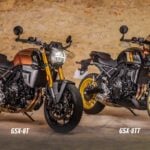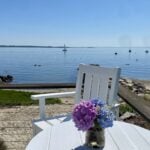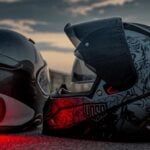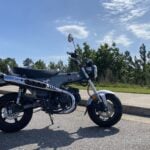We Commute, Day Ride, and Road Trip on the Indian FTR 1200 S
Ever since the stunning debut of Indian’s flat track dominating FTR750 racer in 2016, riders have been clamoring for a street version. By the end of 2018, Indian delivered, unveiling the street FTR 1200 to much fanfare across the motorcycle industry. As their phrase declares, “Born in the Dirt; Built for the Street”, The FTR 1200’s DNA is clearly bred in racing. Tall suspension, tight wheelbase, flat tracker handlebars, trellis frame, even ADV on/off road rubber on cast aluminum rims, the bike screams hooligan, with a huge shout-out to its championship-winning 750 sibling.
I’d been following the development of the race bike, watching their first winning performances at the 2017 opening AFT round at Dixie Speedway north of Atlanta, and suspected early on that a street version would soon be in the offing. I didn’t have to wait long. Since Indian began teasing the release of the FTR 1200, I’ve kept a keen interest, and since it debuted late 2018-early 2019, I’ve longed to get my hands on one.
Finally, my wait was over.
Through my contact with Robert Pandya, moto-journalist and former staffer with Indian Motorcycles, I connected with two fellas at Indian HQ in Springfield, Mass, and several guys with The Brand Amp here in Atlanta, which handles a lot of marketing for Indian. They hooked me up with a press demo bike they had in Florida, shipped it to Indian Mall of Georgia who serviced it for me, and I picked it up on a hot Georgia Wednesday in late September. According to one of the service techs at Indian MoG, “Looks like the last journalist who had this did nothing but burnouts in a parking lot with it.” Sure enough, the center of the rear tire already had considerable wear, on an odometer reading of only 155 mi. I instantly knew the angle we needed to pursue with the FTR. All the big motorcycle publications, media outlets, and video channels had been showcasing the raw power of the bike, with nonstop wheelies, power slides, burnouts, and pinning the rev limiter with it. Power-to-weight, dyno charts, spec sheets. Already done.

Our take would be different.
If you consider purchasing this bike, those might get your attention. But your real questions are probably more like ours-
What’s the FTR like to live with? What’s it like to commute to work or school on? What’s it like for late afternoon or Saturday curve carving day rides? What’s it like to road trip with? Nobody (that I know of yet) had bothered to report on these. So we did.
COMMUTING
My first couple of days were spent using the FTR as a commuter bike for a couple of my “day job” gigs. Navigating in hot, congested, north Atlanta traffic, the FTR is lighter than it looks, and its compact stance makes it quite easy to maneuver through lanes and vehicles. Outfitted with fantastic Brembo brakes fore and aft, coupled with switchable ABS and traction control, the bike can be brought to a halt rather suddenly. I had occasion to sample the stopping prowess the very first day, when a car about 3 vehicles ahead of me suddenly slammed his brakes on for some reason, causing each subsequent vehicle to crunch down as well, including me. I bit down hard on the binders, front and rear, and the bike rapidly decelerated. The FTR came to a sharp but very controlled stop, with no jacking, sliding, or rear wheel lifting. I was pleasantly surprised.
I must add that the FTR 1200 also boasts incredible engine braking. By downshifting when approaching stops, I found the engine itself decelerates rapidly, and coupled with the chain drive, slows the bike amazingly well. I often wouldn’t even squeeze the brakes at all until I needed to come to a complete stop, the bike engine brakes so well.
One caveat- around town and in traffic, the engine compartment radiates quite a lot of heat, most notably against my inner thighs. This is mainly due to the lack of plastic fairing on the bike, and the fact that the seat nearly straddles the rear cylinder housed in the frame underneath it. I suppose heat is to be expected with a “naked” bike. I only really found it uncomfortable in stop/go traffic, and even then it was bearable between lights.
The non-glare TFT display 1st screen shows mph, gear position, miles to E, total odometer miles, internal and outside ambient temps, even compass direction. Quite a nice display. It switches to night mode automatically at dusk, which I found a pleasant surprise one evening on my way home, as it switched the exact moment I happened to glance at the screen. Very cool. The 2nd screen gives access to settings for gauges, linking a phone and music, three ride modes (rain, standard, and sport), the TC/ABS settings, and deeper settings for engine oil life, etc. All easy accessed via buttons on the left side of the screen, or on the fly while riding via a menu button and toggle on the left handlebar. The Indian TFT display is the easiest, simplest one I’ve ever used on a bike. A fantastic design.
My one issue was with the “Miles to E” dial. The outer digital needle and the inner miles-remaining number never seemed to match. I didn’t know which one to trust. I know the underseat tank holds about 3.4 gallons, but I never felt comfortable going more than about 125 miles between refills, the fuel gauge confused me so much. Hey, that’s a pretty good distance to get off and take a break anyway!
DAY RIDING
I didn’t have as many opportunities just to take off and day ride as I’d have liked, since I ended up sick for four days by the first weekend, and couldn’t ride at all. When I was well enough to ride again, I took several 2-3 hour late afternoon/early evening rides, getting out on the FTR and blasting down country roads just for the jollies. And believe me, the Indian delivers plenty to be jolly about. The bike gives immediate throttle response, and shifting through the gearbox is effortless and precise, the clutch pull perfect. The FTR can carve through curves with panache, with deep lean angle sensitive ABS, stability/traction/wheelie control, and rolling on firmly planted Dunlop OEM rubber. It is a sport suspension on this the S model, by the way. The FTR S makes 123 horses, expends gases via a growling Akrapovic exhaust, and I found makes peak torque around 6000 RPM. It’s a rev monster, pulling hard above 5000 RPM. Quite entertaining, I must say. The engine is of course, a V-twin, yet is water cooled, fuel injected, DOHC, with a slip-assist, multi-plate clutch. In high heat, the engine never overheated, with the cooling fan constantly kicking in at precisely 207 degrees whenever needed.

I do need to point out that the FTR 1200 is a bit cold-natured at start, even in warm temps. I generally let the internal temp come up to 130 before I threw a leg over, as taking off while the engine was still cooled resulted in a couple of stalls. Once internal temps were up, the bike ran flawlessly. The Indian FTR 1200 sports a 6-speed gearbox, with plenty of torque and a nice power band spread in each. I enjoyed just punching up and down through the gears, upshifting and downshifting over the winding country roads south of our home.
I switched into Sport ride mode a couple of times, and really didn’t notice a huge performance difference, other than tightening up of the gear ratios, and faster fuel consumption. The Rain mode never got used, as in our drought, we never got rain while I had the bike. I found the Standard ride mode ideal for all conditions, and enjoyed the overall response and feel of the bike in this mode.

We live in the perfect location for here in the Southeast- ride north for about an hour, and we’re in the Appalachians. Ride south of our home, and we’re in the rolling hills of dairy and farm country. Plenty of curves, sweepers, long stretches, and small hills to blast over and around. The FTR is built for this. I did a few local dirt roads, and the bike was planted and stable across gravel, dirt, and loose pavement. But make no mistake, this is primarily a street bike that can handle dirt, not a dirt bike you can ride on the street. There is a difference. If you want the latter, get a small dual-sport. But for fun day rides, and the occasional dirt roads, you’ll be fully satisfied with the Indian FTR.

ROAD TRIPPING
Cycle Gear of Lawrenceville fixed me up with a Sedici T2 Performance tail bag, which was the perfect size and fit for the FTR’s tail section. The bag is expandable, and I had it stretched to the max for my weekend road trip. With a pair of extra bungee straps for good measure, the bag was perfectly stable, didn’t budge, velcroed snugly underneath the rear cowling, and even provided lower back support for me. Only disadvantage, I couldn’t wear my backpack traditionally. So I flipped it around, wore it in the front over my chest, and it rested nicely on the tank/airbox cover. Looked odd, but functioned well.
My destination was Barber Motorsports Park 15th Annual Vintage Motorcycle Festival, a colossal event attracting upwards of 80,000 enthusiasts of vintage bikes and racing, from across the continent. I’ve wanted to make this event for years, so I was eager to hit the highways.
I left out from my home northeast of Atlanta and rode long, winding country roads south until I picked up interstate I-20 West. Clearly the bike is quite fun to ride on curvy country roads as I’ve found, but as I lit out down the interstate, I found the FTR ate highway miles with ease as well. I settled into a comfortable 75mph, right at 4500 rpm, and just ticked off the miles and hours, heading west for Birmingham. I kept the FTR in Standard ride mode, kept the ABS and Traction Control on, and out on the long stretch across eastern Alabama, engaged the Cruise Control. Yes, all three come included on the Sport model.
The Indian’s cruise control I found quite unique, having never used one on a motorcycle before. It is engaged via a button on the left handlebar set of switches, and when you attain your desired speed, you click the switch down, and the CC takes over control of the throttle. The rider can roll on the throttle, or completely release it, and the FTR maintains the set speed perfectly, without deviation. To disengage it, you simply tap the front or rear foot brake, or push in that CC button on the left handlebar, and it cuts off. But be careful to have some throttle rolled in when you disengage it, or you’ll find the amazing engine braking capabilities of the Indian quite jarring at highway speed. Ask me how I know.
Still in a severe heatwave here in the South, Internal temps stayed in the ideal range, around 175-190, even as the outside temps were consistently showing 101 all the way to Barber. I wore a textile armored jacket and gloves, with Kevlar riding jeans, and actually never felt overheated the entire ride. Felt good airflow over the bike, and through my gear. I had to periodically stop for fuel, given the FTR’s limited range, by tank size and gas mileage, letting me log about 125 miles between stops as I stated before. This turned out for the better, given the heat and my need to stay hydrated. I also needed a break from the seat which I found rather hard and uncomfortable on the long haul. Admittedly, my posterior is rather thinly padded to begin with, so I must give Indian a pass on this one.

Arriving finally at Barber, I picked up my press creds and rode into the park in search of my friend Mike Boyd, who was to help me shoot footage of the events and races across the weekend, and had already established a campsite for his “toy hauler” camper. The FTR stands tall for a short guy like me, and also stands tall on its kickstand, leaving me to find as level a spot as possible to park it when in grass. A difficult task, given the hilly terrain the complex is built into. I also procured a kickstand puck, to keep the bike from tipping over in the event of ground softening beneath the stand.

I used the FTR as a park grounds and paddock bike all weekend, leaving my gear in Mike’s camper, and the bike was easy to maneuver all three days around the track, through the swap meets, and to the various concerts, bike shows, fan zones, and special demonstrations across the BMP complex. To help a bit with the seat height (33.1”), I found the rear shock adjustment helpful, by dialing out a bit of stiffness. It’s an easy adjustment with a standard head screwdriver. So rather than standing on my tiptoes straddling the FTR, when I sat on the seat and compressed the suspension, I now was able to rest a bit more comfortably on the balls of my feet. Gave me considerably more confidence in slow, close quarters maneuvering across the crowded facilities. Never a tip-over, never a drop.

By noon on Sunday, both Mike and I decided to button it up and make for our respective homes back in north Georgia. After helping him break camp and load up, I set out eastward myself, this time running state roads through the beautiful northeast Alabama rolling countryside. This was definitely more the realm of the FTR 1200. Winding ribbons of asphalt, through foothills and flat valleys, cotton fields and cattle ranches, small communities and national forests, often with no other vehicles sharing the road with me. Moto heaven.
I must add that the rider triangle on the FTR 1200 suits me very well. A mostly neutral riding position, only a slight lean in with the flat tracker handlebars, brake & clutch pedals and foot pegs comfortably placed like sitting in a chair. Reminds me of the triangle on my Triumph Bonneville Street Cup, since I’ve added the Street Twin bars to it. Very similar, very comfortable for me.
Back on interstate until I got north of Atlanta, the FTR rolled me home about 7pm EST, tired but satisfied. A fantastic road trip on a fantastic motorcycle.
CLOSING THOUGHTS
So, after over two weeks with the Indian FTR 1200 S, Here are my conclusions.
As a commuter, the FTR is quick, light, nimble, and highly maneuverable in and through congested traffic, to and from work.
As a day-rider, the FTR is a freakin’ hooligan bike, as we already knew. Super fun to ride, powerful roll-on at the throttle, flawless shifting through the gears, dives into corners effortlessly, brakes like a boss. A true curve carver, if I’ve ever sat on one.
As a road tripper, the FTR is adequate, but not wholly designed for it. With limited carrying capability, limited fuel range, and no stock wind protection or variable riding positions, one has to get creative to tour with it. Which we did. We’re not faulting the Indian for that, as touring wasn’t the primary purpose of this bike. But, we proved it can be done, and when man & machine are kitted out properly, the bike gets the job done, across the miles and hours. I would recommend a set of street tires at the first rubber swap, as the OEM Dunlops are on/off road tires, and have a short life span.
I had a fantastic time with this bike across the past couple of weeks. I not only enjoyed riding this daily, I bonded with this bike. When I hopped on, I quickly felt fully at home on it. The FTR drips character, exudes prowess. My inner hooligan loves this bike. The price is well worth the experience.
Check out our video review of the bike below or better yet, go check one out for yourself at your nearest Indian Motorcycles dealership. Mine was Indian Mall of Georgia.

Much thanks to Indian Motorcycle for the opportunity, The Brand Amp for delivering the bike to us, and Indian Mall of Georgia for prepping the bike.
Rob
*Photos by Dean Phelps, Rob Brooks
*Videos by Phil Gauthier, Rob Brooks









































Recent Comments